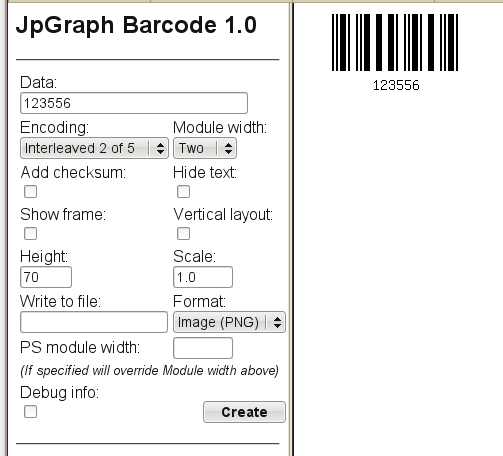This is a summary of the features available in the JpGraph barcode extension.
Supports the following symbologies (with data validation)
UPC A
UPC E
EAN 128
EAN 13
EAN 8
CODE 11 (USD-8)
CODE 39
CODE 128
Industrial 2 of 5
Interleaved 2 of 5
Codabar
Bookland (ISBN)
Input data is verified against the official specification of each symbologies and makes it impossible to create invalid bar codes.
Output format
Image format (either PNG or JPG encoding)
Postscript
Encapsulated postscript
Formatting options
User specified module width. This controls the width of the smallest unity in the barcode.
Automatic calculation of optional checksum for symbologies where the checksum is optional
User specified scaling of resulting bar code
Horizontal or vertical bar code layout
Suppression of human readable text on barcodes
Selectable font for human readable text
Note
The term "symbology" is the term used to describe the combination of encodation method (how characters are translated to bars) and the layout of the bars specified by a particular barcode standard. All of the listed standard symbologies above are still widely used. Many of the symbologies overlap in terms of functionality and multiple symbologies might be possible to use for a particular application unless there is a strict standard that stipulates that a particular symbology should be used.
The reason for the existence of so many symbologies with overlapping functionality is in some cases the result of different companies early on specifying there own patented barcodes in order to gain market shares or in some cases lock customers to a specific brand of scanner. In other cases it is simply the result of that earlier barcodes could not handle new demands.
Even though primarily the JpGraph bar code extension is meant, and designed, to be used as a library within a larger system there is a small demo web application to allow easy creation of linear barcodes bar codes. This application is primarily included as a demo of the features available and not as a finalized product.
The application is available under the directory
"barcode/demoapp" as "index.html"
in the main library directory
Figure 23.2 shows a screen shot of the demo application
We strongly suggest running this demo application to get a feel for what formatting options and how the different symbologies behave.
Tip
There is also a command line utility that allows the creation of
barcodes from the command line
"mkbarcode.php"
